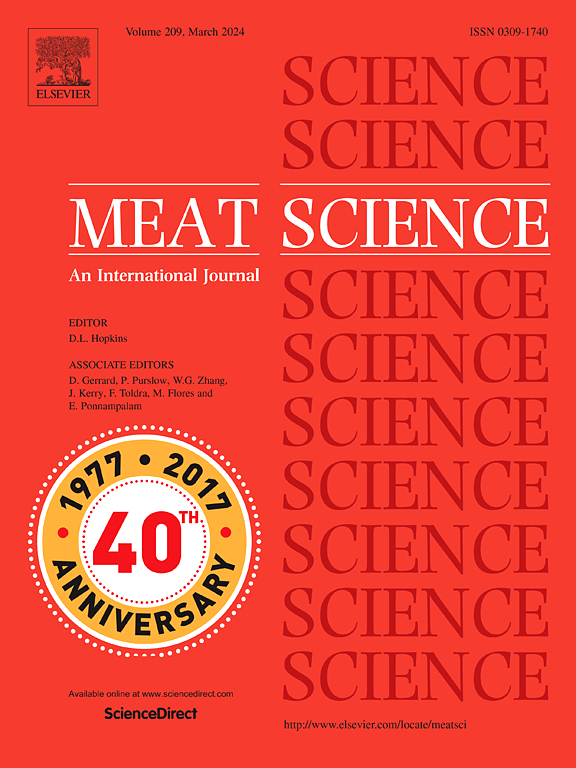Comparison of ultra-wide band microwave system and ultrasound in live cattle to predict beef carcase subcutaneous fatness
IF 7.1
1区 农林科学
Q1 Agricultural and Biological Sciences
引用次数: 0
Abstract
Ultrasound and ultrawide band microwave system (MiS) were directly compared in their ability to scan live cattle to predict carcase traits. Commercial beef cattle (n = 315) were scanned on farm 0–14 days prior to slaughter. Traits measured were subcutaneous fatness at the P8 site (over the gluteus muscle on the rump, at the intersection of a line through the pin bone parallel to the chine and perpendicular through the 3rd sacral crest) and subcutaneous fatness at the rib fat site (between 12th & 13th rib, ¾ of the length ventrally over the longissimus muscle). The precision of prediction of carcase traits was slightly better using MiS. MiS prediction of P8 fat depth had an average RMSEP of 2.48 mm and R2 of 0.65. The MiS could predict carcase rib fat with an average RMSEP of 2.28 mm and R2 of 0.56. The accuracy of prediction was very similar between the two technologies. When predicting P8, the average bias was smallest using MiS at 0.157 mm, but the average slope was smallest using ultrasound at 0.03 mm. When predicting rib fat, MiS had the smallest average bias at 0.204 mm, and smallest average slope deviation at 0.06 mm. The MiS predicted P8 and rib fat carcase traits with similar precision and accuracy as ultrasound.
比较超宽带微波系统和超声波在活牛身上的应用,以预测牛肉胴体皮下脂肪含量
直接比较了超声波和超宽带微波系统(MiS)扫描活牛以预测胴体特征的能力。屠宰前 0-14 天在农场对商品肉牛(n = 315)进行扫描。测量的性状是 P8 点皮下脂肪含量(臀部臀肌上方,平行于脊柱的针骨与垂直于第 3 骶骨嵴的连线交点处)和肋骨脂肪点皮下脂肪含量(第 12 和amp 之间;第 13 肋骨,腹侧长肌上方长度的 3/4)。使用 MiS 预测胴体性状的精度略高。MiS预测P8脂肪深度的平均RMSEP为2.48毫米,R2为0.65。MiS 预测胴体肋骨脂肪的平均 RMSEP 为 2.28 毫米,R2 为 0.56。两种技术的预测准确度非常接近。在预测 P8 时,MiS 的平均偏差最小,为 0.157 毫米,而超声波的平均斜率最小,为 0.03 毫米。在预测肋骨脂肪时,MiS 的平均偏差最小,为 0.204 毫米,平均斜率偏差最小,为 0.06 毫米。MiS 预测 P8 和肋脂胴体性状的精度和准确度与超声波相似。
本文章由计算机程序翻译,如有差异,请以英文原文为准。
求助全文
约1分钟内获得全文
求助全文
来源期刊

Meat Science
工程技术-食品科技
CiteScore
12.60
自引率
9.90%
发文量
282
审稿时长
60 days
期刊介绍:
The aim of Meat Science is to serve as a suitable platform for the dissemination of interdisciplinary and international knowledge on all factors influencing the properties of meat. While the journal primarily focuses on the flesh of mammals, contributions related to poultry will be considered if they enhance the overall understanding of the relationship between muscle nature and meat quality post mortem. Additionally, papers on large birds (e.g., emus, ostriches) as well as wild-captured mammals and crocodiles will be welcomed.
 求助内容:
求助内容: 应助结果提醒方式:
应助结果提醒方式:


